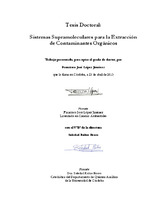Mostrar el registro sencillo del ítem
Sistemas supramoleculares para la extracción de contaminantes orgánicos
| dc.contributor.advisor | Rubio Bravo, Soledad | |
| dc.contributor.author | López-Jiménez, Francisco José | |
| dc.date.accessioned | 2013-05-28T11:47:21Z | |
| dc.date.available | 2013-05-28T11:47:21Z | |
| dc.date.issued | 2013 | |
| dc.identifier.uri | http://hdl.handle.net/10396/10185 | |
| dc.description.abstract | The results of the investigations of this Thesis have been divided in two sections. An Introduction is presented first that provides a general view of the main theoretical and practical aspects reported for the three types of supramolecular systems used in these investigations, namely hemimicelles, mesoporous materials and coacervates or supramolecular solvents. Main contents of the two sections are summarized below. SECTION I: Adsorbents for solid phase extraction (SPE): hemimicelles and silica mesoporous materials. This section includes two chapters. The first one describes the results obtained from the use of hemimicelles of dodecylsulphate as an adsorbent in SPE for the extraction of phthalic acid esters from wastewater. The second one deals with the evaluation of a silica mesoporous material (MSU-1) in the extraction of benzalkonium compounds from wastewater using the template effect. MSU-1 was synthesized from autoassembled structures of the nonionic surfactants Tergitol 15-S-12. SECTION II: Supramolecular solvent-based microextraction. The supramolecular solvents (SUPRAS) used in the investigations reported in this section have been obtained from different types of aggregates (reversed micelles and vesicles), they have been applied to the extraction of contaminants from a variety of food and environmental samples, and microextractions have been carried out involving different formats (e.g. liquid-liquid-solid, liquid-solid and single drop microextraction) Thus, the third chapter in this Thesis deals with the microextraction of Sudan dyes from chili-containing sauces using SUPRAS made up of reverse micelles of decanoic acid, which was synthesized in the presence of the sample and therefore three phases were in equilibrium after extraction, namely the SUPRAS, the equilibrium hydroorganic phase and the non dissolved sample. In the fourth chapter, a SUPRAS made up of reverse micelles of decanol with restricted access properties is proposed for the simultaneous microextraction and cleanup of endocrine disruptors from sediments. Humic and fulvic acids are not extracted and SUPRAS extracts are analyzed directly without further treatment. The fifth chapter deals with the microextraction of four polycyclic aromatic hydrocarbons considered as an indicator of food contamination for these carcinogenic. For purpose a SUPRAS made up of vesicular aggregates of octanoic acid was applied to the microextraction of these PAHs in meat and fish foodstuffs. The sixth chapter describes the use of SUPRAS in single drop microextractions for the first time. Theoretical and practical aspects of this microextraction format are discussed in detail and a method for the determination of chlorophenols in environmental waters is developed. This Thesis report also includes a part in which the results are discussed as a whole, highlighting the most relevant contributions, and a last section where the main conclusions drown from research work are shown. Finally, two appendices are annexed to this Thesis report, where the scientific publications and congress contributions derived from this thesis are compiled. | es_ES |
| dc.format.mimetype | application/pdf | es_ES |
| dc.language.iso | spa | es_ES |
| dc.publisher | Universidad de Córdoba, Servicio de Publicaciones | es_ES |
| dc.rights | https://creativecommons.org/licenses/by-nc-nd/4.0/ | es_ES |
| dc.subject | Contaminantes orgánicos | es_ES |
| dc.subject | Análisis | es_ES |
| dc.subject | Sistemas supramoleculares | es_ES |
| dc.subject | Microextracciḉon líquido-líquido | es_ES |
| dc.title | Sistemas supramoleculares para la extracción de contaminantes orgánicos | es_ES |
| dc.type | info:eu-repo/semantics/doctoralThesis | es_ES |
| dc.rights.accessRights | info:eu-repo/semantics/openAccess | es_ES |

